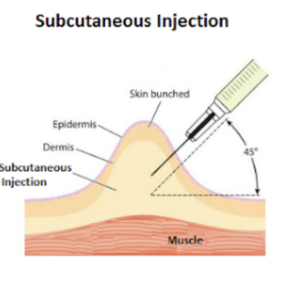
Subcutaneous Injection: Understanding the Basics
Subcutaneous Injection: Understanding the Basics
Introduction:
Medical advancements have brought forth numerous methods of administering medications, each tailored to specific needs and conditions. One such method is subcutaneous injection, which plays a crucial role in delivering medication to patients efficiently and safely. In this blog post, we will explore what subcutaneous injection entails, its benefits, and how it is performed.
Understanding Subcutaneous Injection:
A subcutaneous injection is a type of medication administration that involves delivering a drug into the subcutaneous tissue, which lies just beneath the skin. This route of administration allows for the slow and controlled release of medication into the bloodstream, ensuring its proper absorption and effectiveness.
Benefits of Subcutaneous Injections:
Subcutaneous injections offer several advantages that make them suitable for specific medications and patient populations:
1. Controlled Absorption: Subcutaneous injections provide a controlled and steady release of medication into the bloodstream. This helps maintain a stable therapeutic level over an extended period, optimizing the drug’s efficacy.
2. Convenient and Painless: Subcutaneous injections are generally less painful than other routes, such as intramuscular injections. The subcutaneous tissue has fewer nerve endings, resulting in reduced discomfort during the injection process.
3. Self-Administration: Some medications can be self-administered via subcutaneous injections. This empowers patients to take control of their treatment at home, promoting independence and convenience while maintaining their health.
4. Suitable for Various Medications: Subcutaneous injections are commonly used for delivering medications such as insulin, growth hormones, vaccines, and certain biologic drugs. These medications require a slow release into the bloodstream to achieve the desired therapeutic effect.
Performing a Subcutaneous Injection:
To perform a subcutaneous injection, follow these general steps:
1. Preparation: Gather the necessary supplies, including the medication, a sterile syringe, an appropriate needle, alcohol swabs, and a sharps container for safe needle disposal. Wash your hands thoroughly.
2. Site Selection: Identify suitable injection sites, commonly the fatty areas of the abdomen, thighs, or upper arms. Rotate the injection sites to prevent tissue damage or lipodystrophy.
3. Cleaning: Cleanse the chosen injection site with an alcohol swab and allow it to air dry. This helps reduce the risk of infection.
4. Assembling the Syringe: Most syringes are single use pre-assembled.
5. Injection Technique: With a quick and controlled motion, insert the needle into the subcutaneous tissue at a 45-degree or 90-degree angle, depending on the needle length and patient’s body habitus. Slowly push the plunger to administer the medication.
6. Needle Removal and Disposal: Once the medication is injected, withdraw the needle gently. Dispose of the used needle in a sharps container to ensure safe disposal.
7. Post-Injection Care: Apply gentle pressure to the injection site with a sterile cotton ball or gauze pad. Do not rub the area. If bleeding occurs, apply light pressure until it stops.
Conclusion:
Subcutaneous injection is a widely used method of medication administration that offers controlled and effective drug delivery. Its benefits, including convenience, self-administration potential, and minimal discomfort, make it a preferred choice for certain medications and patient populations. By understanding the basics of subcutaneous injections and following proper techniques, patients and healthcare professionals can ensure safe and successful administration of medications, ultimately improving patient outcomes.
As per our terms this article is for information purposes only
Normal type
If slimmer you may need to insert at 45 degrees to avoid going into the muscle layer








This Post Has 0 Comments